Table of Contents
Software technical documentation is an essential part of every development project, and it’s crucial to have it in place to achieve the expected results.
Documents created at various stages of the software development life cycle (SDLC) benefit different participants (e.g., clients, CTOs, developers) but are equally helpful and useful for all of them.
In this article, we will examine the basics of software documentation (i.e., what it is and why you need it) and provide brief information about the different types of documentation required to receive a quality product.
What is software documentation, and what is it for?
Software documentation serves as a communication bridge between stakeholders, ensuring that all parties involved clearly understand the project.
A well-structured documentation process reduces misunderstandings, helps onboarding new team members, and aids in maintaining the software over time.
As you may have already guessed, software documentation is a set of documents that either accompany a software product or are embedded in its source code.
The exact naming and style of SDLC documentation depend on the development methodology applied in each case.
For example, software documentation in traditional management (i.e., waterfall methodology) is more static (i.e., it isn’t subject to changes during the development process) and detailed (i.e., all the details are documented really scrupulously).
At the same time, the agile approach suggests that only the most necessary information should be formalized.
There is a continuous discussion about which methodology and best practices in software development life cycle documentation are more efficient for a successful product launch.
We’ll not dive into this since it is not a subject of this article. But, in general, regardless of the chosen approach and the form of presentation of information, software documentation should perform the following tasks:
- formalize a common understanding of a product to be developed, functions it must perform, and features it should include
- show how the software operates
- explain how to use the software
Different software development documents cover the above tasks. Below, we describe the development documentation involved in each stage of software engineering.
A recent Consortium for IT Software Quality (CISQ) study found that effective documentation can reduce maintenance costs by up to 30%, emphasizing its role in long-term project success.
Pre-development documentation
The main goal of pre-development software product documentation is to describe what needs to be developed and how it will be developed. It usually comprises the following documents.
Vision statement
A vision statement (sometimes also referred to as a Vision and Scope Document) is a piece of software documentation containing a high-level description of a project: its main objective, the general functionality of a product (i.e. what it will/will not do) and key milestones or phases of the relevant development process.
Besides plain text, it may include illustrations, graphs and other visual elements.
A vision statement usually does not go into much detail, and it is mainly used to establish a common understanding of the key points of a project between a client and a development team.
Initial assessment document
The initial assessment document offers a more accurate description of the stages of a development process, a list of tasks that developers must perform, and an estimation of the time needed to accomplish each task.
It also contains an estimation of a project budget and is, thus, one of the most important pieces of software project documentation for product owners at the preparation stage.
Roadmap
A roadmap is another piece of documentation in which a software project may be formalized. Simply put, it’s a visualized plan showing a timeline and the whole process of the development of a particular digital product. A product roadmap captures long-term and short-term goals, priorities, deliverables, dependencies and actions to be taken by developers.
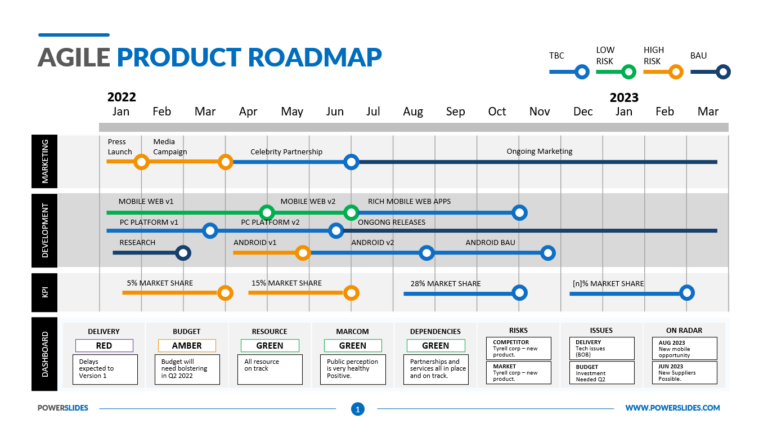
After it’s built, a roadmap is shared with all development team members and a client. It helps to keep track of the process and makes it straightforward and transparent.
A product owner may also use it to envision a release of future software functionality.
A roadmap may look thousands of different ways, but here’s a simple example to give you a general idea:
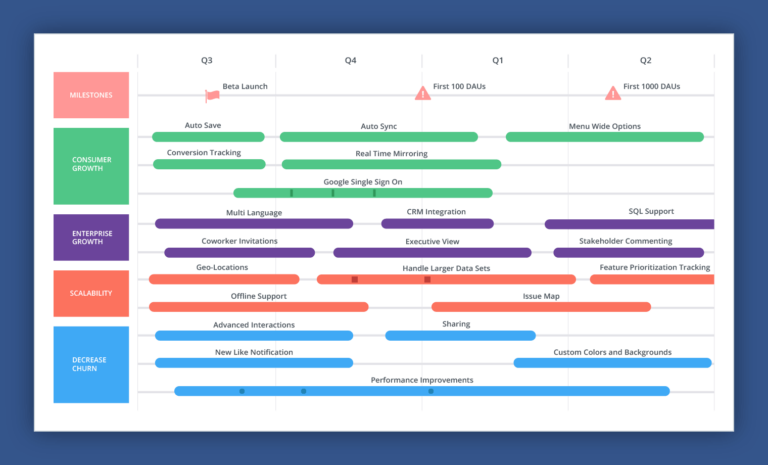
Technology stack
A technology stack is a software engineering document that constitutes a list of technologies (software products and programming languages) to be used to develop a digital product.
These could be, for example, Linux, Apache, MySQL, PHP, Ruby, Python (back-end) or HTML, CSS, or JavaScript (front-end).
As a rule of thumb, a technology stack is created along with a vision statement, an initial assessment document and a product roadmap, since technology tools needed for a project may influence its budget significantly.
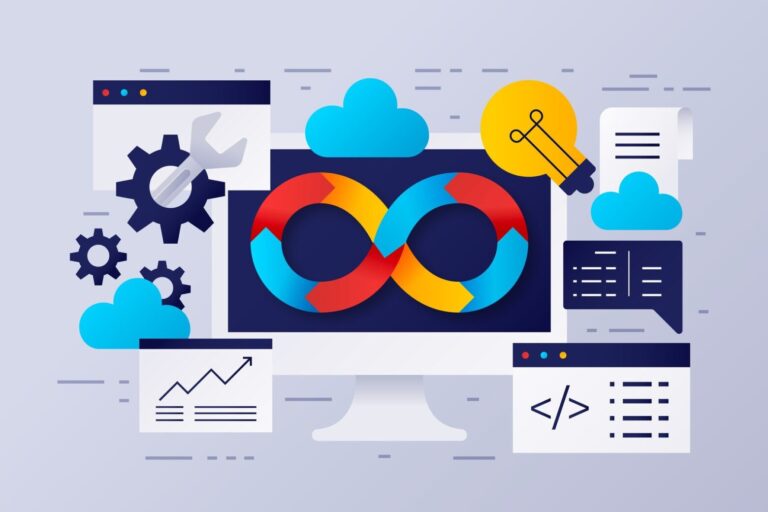
SRS is an in-depth and comprehensive description of the software to be developed. As mentioned, the level of formality of these documents depends on the chosen methodology (i.e. waterfall or agile).
The choice between agile and waterfall methodologies significantly impacts documentation practices. Agile documentation emphasizes flexibility and adaptability, focusing on delivering essential information quickly, whereas waterfall documentation is more rigid and detailed, requiring comprehensive documentation upfront.
However, in general, SRS should capture the functional and non-functional (system, technical) requirements of a product, as well as constraints, assumptions, and acceptance criteria. In other words, this piece of software engineer documentation shows how a software product will interact with the hardware, users and other programs.
SRS is often written in the form of a set of use cases. A use case describes actions to be taken by a person (usually referred to as an actor) to achieve particular goals using a digital product. For example:
Edit profile
Upon registration with first login user is redirected to “User profile” page. When user clicks on his avatar in header and sees a dropdown, there’s an option to get to Edit profile page too.
In addition, some elements of the functionality may be described in separate user stories. They are written from the perspective of an end-user and are generally considered a simplified version of a specific requirement. Here’s is an example:
As an equipment owner, I want to
SIGN UP PAGE
- create a profile.
- create a profile using social network.
PROFILE SETTINGS
- input my basic info, contact information, choose interests and set avatar
- add credit card for payments.
SRS is undoubtedly the most important document in each development project. It comprehensively formalizes the wishes of a product owner, simplifies communication among members of a development team and minimizes time and money required to develop a final product.
Hence, it’s crucial to have professionals write SRS.
Wireframes and UX Roadmap
A wireframe is a part of design documentation in software engineering. It’s a rough illustration of a page’s interface that focuses on laying out content, space allocation and functionality.
A wireframe of a typical page usually does not include images and many colours (if any) but shows logos, body content, search fields, share buttons, etc.

Wireframes themselves do not capture the interactions between different pages. To demonstrate what happens if a user pushes a specific button, a UX roadmap is designed.
A UX Roadmap is all wireframes put together with arrows or other graphical elements depicting what an app will do (i.e. what next page it will open) if a user takes any action.
A UX roadmap is an optional document, meaning that, in some instances, the software may be developed without it. However, as we see from practice, this document really makes a project’s final result more predictable, and for this reason, we strongly recommend building it before designing any digital product.
The main goal of wireframes and a product roadmap is the same, i.e. to illustrate how the determined functionality will be reflected in the interface.
It also makes a further designing process go smoothly, so a product owner may approve a visual appearance of a product early in the project before things get way too creative.
If you don’t want to take risks and wish to receive the expected results in the end, we recommend having wireframes and a UX roadmap developed in all instances.
Software Development documentation process
To create effective documentation, it’s essential to tailor the content to the intended audience, utilize clear and concise language, and maintain consistency in style and format. Regular updates and revisions ensure that the documentation remains relevant and useful throughout the project lifecycle.
What is included in a software development documentation best practices?
Development documentation comprises documents created in the course of the software engineering process. There are only two main types of them:
Coding documentation
Coding documents constitute a piece of system documentation. Basically, it’s a source code used to program a digital product.
Its main aim is to show how the software works and clarify the logic behind a product to developers and product owners. Code documents should also contain developers’ comments explaining complex code sections.
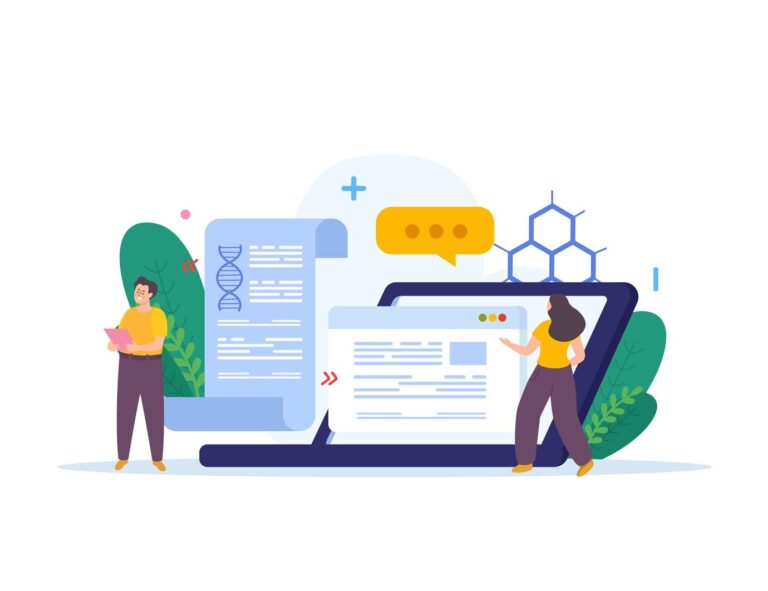
Testing documentation
Testing documents are software development documents created as a part of a quality assurance process by testing teams and developers.
They capture how the testing of a product was planned, designed and executed, as well as show the results received in the end.
Testing documentation is needed to explain how a product is validated. There are different types of documents developed throughout the testing process, such as test plans, test procedure descriptions, test summary reports, etc.
Post-development documentation
In short, post-development documents are aimed at making the users’ lives easier by explaining to them how to install, maintain and use a product. They include the following documentation types.
Support papers
These documents are mainly used by tech departments responsible for managing software. They explain how to maintain the software and how to address different issues that may occur.
Installation guides
The name is self-explanatory. This document contains instructions on how to install an application.
User manual
User manuals constitute application documentation aimed at end-users and describe how to use a digital product.
User documentation best practices suggest that a user manual should be written in simple language without going into too many technical details.
If you don’t feel confident about writing post-development documents, contact professionals.
Who writes tech documentation?
Tech documentation is a key component of software and hardware development, helping users and developers understand how to utilize a product effectively.
However, creating this documentation is often collaborative, involving various professionals with different skill sets and expertise. Here’s a closer look at who typically writes tech documentation and their roles in the process.
Technical Writers
Technical writers specialize in creating easy-to-understand documentation. Their strong writing and communication skills allow them to translate complex technical concepts into accessible language.
Their primary goal is to produce clear and concise content, including user manuals, installation guides, and API documentation.

Technical writers often work closely with other team members to gather information, ensuring the documentation accurately reflects the product.
They may also conduct user research to understand the target audience’s needs, helping them tailor the content appropriately.
Software Developers
Software developers play a major role in writing tech documentation, particularly when it comes to explaining how a product works from a technical standpoint.
They may produce documentation as part of the development process, creating content that explains code functionality, system architecture, and integration points.
Developers often write inline comments within the code to clarify specific functions or logic, providing context for future developers or users interacting with the codebase.
Additionally, they may contribute to user guides and technical specifications to ensure that all software aspects are comprehensively documented.
Product Managers
Product managers help shape a product’s direction, and their insights are invaluable when it comes to documentation.
They often provide input on what should be included in user manuals and guides, ensuring that the documentation aligns with the product’s features and intended user experience.
By understanding user needs and market trends, product managers can help technical writers and developers focus on the most relevant information, enhancing the documentation’s effectiveness.
Their perspective ensures that the documentation serves its purpose in helping users navigate the product.
Subject Matter Experts (SMEs)
Subject matter experts (SMEs) possess deep knowledge in specific areas, such as industry standards, regulatory requirements, or technical specifications.
They contribute by providing detailed information that can enhance the accuracy and depth of the documentation.
SMEs often work with technical writers to ensure that the content reflects their field’s latest standards and practices. Their expertise is crucial for creating documentation that is not only informative but also compliant with relevant regulations or guidelines.
User Experience (UX) Designers
User experience designers focus on a product’s overall usability, and their input is essential when creating documentation.
They may develop user guides, help content, or onboarding materials that reflect the user’s perspective, ensuring the documentation is user-friendly and easy to follow.
By considering the user’s journey, UX designers can help identify potential pain points in the documentation and suggest improvements. They aim to create a seamless experience for users as they interact with the product.
Quality Assurance (QA) Testers
QA testers often write documentation based on their testing processes and findings. They create content that helps users troubleshoot common issues or understand the testing methodologies used during development.
By documenting their testing experiences, QA testers can provide valuable insights into the product’s functionality and limitations, helping users make informed decisions. Their contributions ensure that the documentation covers practical scenarios that users may encounter.
In a nutshell, tech documentation is created by a diverse group of professionals, each bringing their unique expertise to the table.
Technical writers, software developers, product managers, subject matter experts, user experience designers, and quality assurance testers all play essential roles in producing clear, accurate, and useful documentation.
By collaborating throughout the documentation process, these professionals help ensure that users have the information they need to navigate and use technology products effectively.
Bottom line
Properly formalized software development documentation is a must if you want your software project to go smoothly and successfully. To avoid mistakes and capture all crucial aspects of the development process, we recommend hiring a tech team that will create SRS, wireframes, a UX roadmap, and user documents for you.
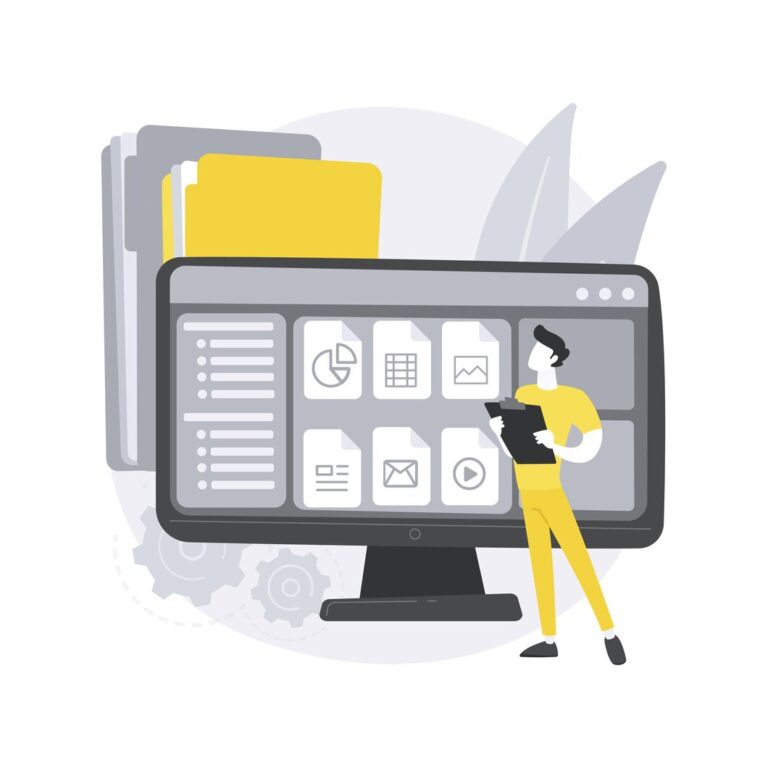
Pro tips for practitioners
- Use Version Control: Implement version control systems for documentation to track changes over time and collaborate efficiently with team members.
- Incorporate Feedback Loops: Regularly gather feedback from users and stakeholders on the documentation’s usefulness and clarity and make necessary adjustments based on their input.
- Stay Updated on Tools: Familiarize yourself with modern documentation tools and platforms that facilitate easier collaboration, organization, and retrieval of documents.
- Prioritize Usability: Ensure that documentation is easy to navigate by using clear headings, bullet points, and visuals, making it more accessible for all users.
- Focus on Continuous Improvement: Regularly review and update documentation practices to align with industry standards and to incorporate lessons learned from past projects.
Altamira team is committed to producing high-quality technical documentation that is clear and effective. Each member of our team brings their expertise to the table, ensuring that the documentation is accurate and relevant to users’ needs. Contact us to get a free expert consultation regarding your project.
People also asked
In software development, there are four main types of documentation:
- User Documentation: This type is aimed at end users and includes manuals, tutorials, and FAQs that help users understand how to use the software effectively.
- Technical Documentation: Intended for developers and IT professionals, this documentation provides in-depth information about the system architecture, APIs, and integration points.
- Process Documentation: This outlines the methodologies and processes followed during development, including project plans, workflows, and quality assurance practices.
- System Documentation: This includes information about the software’s infrastructure, hardware, and network configurations, providing a comprehensive view of the system as a whole.
Software development documentation refers to the various materials created during the development process that describe the software’s design, functionality, and usage.
It serves as a guide for developers, users, and stakeholders, ensuring everyone has a clear understanding of how the software works and how to interact with it. This documentation is essential for maintaining the software over time, facilitating onboarding, and providing support.
Developer documentation should include several key elements:
- Code Examples: Clear snippets that illustrate how to implement features or use APIs.
- Installation Instructions: Step-by-step guidelines for setting up the development environment.
- Configuration Guidelines: Details on how to configure the software to meet specific requirements.
- Architecture Overview: An explanation of the system’s structure and design principles.
- Troubleshooting Tips: Common issues and solutions that developers may encounter during implementation.
The four pillars of documentation are:
- Clarity: Documentation should be easy to understand, avoiding jargon and complex language.
- Accuracy: Information must be precise and reflect the current state of the software.
- Completeness: All necessary information should be included to give users a full understanding of the software.
- Consistency: Terminology and formatting should remain uniform throughout the documentation to avoid confusion.
An example of coding documentation is a README file included in a software project. This file typically contains important information about the project, including:
- A brief description of the software and its purpose.
- Instructions for installation and setup.
- Usage examples and code snippets.
- Contribution guidelines for other developers who want to contribute to the project.
This type of documentation helps users and developers understand the project quickly and facilitates collaboration.




